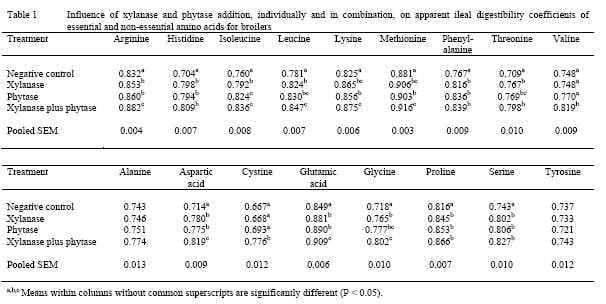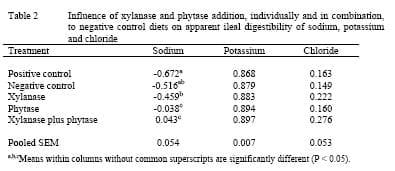Supplementation of wheat-based broiler diets with xylanase and phytase, individually and in combination
Published: August 3, 2009
By: D.J. CADOGAN, P.H. SELLE, G.G. PARTRIDGE and V. RAVINDRAN
Summary
The combined inclusion of xylanase plus phytase in a wheat-based diet increased the ileal digestibility coefficients of 17 amino acids by an average of 8.6% (0.830 versus 0.764), which exceeded the average increases individually generated by xylanase (4.8%) or phytase (5.5%). Of probable relevance is that the combination of xylanase plus phytase markedly increased ileal digestibility of sodium from -0.516 to 0.043.
The combined inclusion of xylanase plus phytase in a wheat-based diet increased the ileal digestibility coefficients of 17 amino acids by an average of 8.6% (0.830 versus 0.764), which exceeded the average increases individually generated by xylanase (4.8%) or phytase (5.5%). Of probable relevance is that the combination of xylanase plus phytase markedly increased ileal digestibility of sodium from -0.516 to 0.043.
I. INTRODUCTION
The simultaneous inclusion of exogenous xylanases and phytases in wheat-based broiler diets is an increasingly common practice. Despite initial indications that this approach held promise (Zyla et al., 1999), few relevant studies have been reported, particularly where the effects of enzymes on ileal amino acid digestibility have been determined. The purpose of this study was to determine the effects of xylanase and phytase, individually and in combination, on digestibility of amino acids and electrolytes (sodium, potassium, chloride) in diets based on a selected wheat.
The simultaneous inclusion of exogenous xylanases and phytases in wheat-based broiler diets is an increasingly common practice. Despite initial indications that this approach held promise (Zyla et al., 1999), few relevant studies have been reported, particularly where the effects of enzymes on ileal amino acid digestibility have been determined. The purpose of this study was to determine the effects of xylanase and phytase, individually and in combination, on digestibility of amino acids and electrolytes (sodium, potassium, chloride) in diets based on a selected wheat.
II. MATERIALS AND METHODS
A wheat with a pre-determined AME of 12.3 MJ/kg, which contained 9.2 g/kg soluble NSP and 1.90 g/kg phytate-P was used to formulate positive (3.8 g/kg nonphytate-P) and negative (2.6 g/kg) control diets. Xylanase (2000 XU/kg; Avizyme 1310) and phytase (500 FTU/kg; Phyzyme XP), individually and in combination, were added to the negative control diet. The practical diets were based on wheat, soyabean meal and canola meal and contained 3.0 g/kg titanium oxide as an inert marker. Each of the five dietary treatments was offered to six cages of eight male chicks (Ross 308) from day 1 to 21 post-hatch. On Day 21, all birds were euthanased with sodium pentobarbitone and contents of the lower ileum were expressed and digesta from birds within a pen were pooled. Concentrations of amino acids, sodium (Na), potassium, chloride and titanium oxide in diets and digesta were analysed to determine apparent ileal digestibility (AID) coefficients.
A wheat with a pre-determined AME of 12.3 MJ/kg, which contained 9.2 g/kg soluble NSP and 1.90 g/kg phytate-P was used to formulate positive (3.8 g/kg nonphytate-P) and negative (2.6 g/kg) control diets. Xylanase (2000 XU/kg; Avizyme 1310) and phytase (500 FTU/kg; Phyzyme XP), individually and in combination, were added to the negative control diet. The practical diets were based on wheat, soyabean meal and canola meal and contained 3.0 g/kg titanium oxide as an inert marker. Each of the five dietary treatments was offered to six cages of eight male chicks (Ross 308) from day 1 to 21 post-hatch. On Day 21, all birds were euthanased with sodium pentobarbitone and contents of the lower ileum were expressed and digesta from birds within a pen were pooled. Concentrations of amino acids, sodium (Na), potassium, chloride and titanium oxide in diets and digesta were analysed to determine apparent ileal digestibility (AID) coefficients.
III. RESULTS

The influence of enzyme inclusions to the negative control diet on ileal amino acid digestibility is shown in Table 1. Xylanase significantly increased the ileal digestibility of 13 amino acids and increased AID coefficient of 17 amino acids by an average of 4.8%. Phytase significantly increased the digestibility of the same 13 amino acids with an overall, average increase of 5.5%. In combination, xylanase plus phytase significantly increased the digestibility of 15 amino acids: arginine (6.0%),histidine (14.9%), isoleucine (10.0%), leucine (8.5%), lysine (6.1%), methionine (4.0%), phenylalanine (9.4%), threonine (12.6%), valine (9.5%), aspartic acid (14.7%), cystine (16.3%), glutamic acid (7.1%), glycine (11.7%), proline (6.1%) and serine (11.3%). The overall, average increase was 8.6%. Responses to xylanase plus phytase were generally of a greater magnitude and the percentage increases generated by the combination exceeded the sum of the increases of the individual enzymes for five amino acids: arginine, valine, alanine, cystine and tyrosine. The ileal digestibilities of potassium and chloride were not influenced by treatment. However, the AID coefficient of sodium in the low-P diet of -0.516 was significantly increased to 0.043 by xylanase plus phytase and to -0.038 by phytase alone (Table 2).

IV. DISCUSSION
The wheat used in the present study contained moderate concentrations of soluble NSP and phytate; nevertheless, xylanase plus phytase increased amino acid digestibilities by an average of 8.6%. Assessments of xylanase plus phytase on ileal amino acid digestibility in broilers appear to be confined to two studies. Ravindran et al. (1999) reported that xylanase plus phytase increased AID coefficients of 14 amino acids by an average of 8.7% (0.868 versus 0.800) in wheat-casein diets and Selle et al. (2003) found that the combination increased AID coefficients of 16 amino acids by 4.6% (0.816 versus 0.781) in diets based on a wheat-sorghum blend. In both studies, the percentage increases generated by the combination exceeded the sum of the increases of the individual enzymes for the majority of amino acids assessed. Therefore, in the present and previous studies, more robust increases in amino acid digestibility were observed with the combination in comparison to individual enzymes and, at times, these responses were of a synergistic nature. The quantities of ileal digestible amino acids generated by xylanase and phytase, particularly in combination, are indicative of the magnitude of matrix values that could be applied to the least-cost formulation of wheat-based broiler diets with added phytase plus xylanase in practice.
The simultaneous inclusion of xylanase and phytase in wheat-based broiler diets generates more robust responses than the individual components. Importantly, Parkkonen et al. (1997) found that xylanase increased access of proteolytic enzymes to their substrates in the aleurone layer, presumably by degrading the cell wall matrix under in vitro conditions. Phytate is concentrated in the aleurone of wheat so the likelihood is that xylanase similarly facilitates phytase activity by increasing substrate access so it is possible that phytate degradation by phytase is enhanced by the presence of xylanase. Additionally, the absorption of nutrients liberated by phytase may be increased by xylanase-induced reductions in gut viscosity.
In this study xylanase did not influence ileal Na digestibility; however, the impact of phytase and the enzyme combination on Na was quite profound as AID coefficients were restored to ‘parity’. This is consistent with the findings of Ravindran et al. (2006) who demonstrated that phytate has the capacity to drag Na into the small intestinal lumen and that this shift is ameliorated by phytase and similar findings have been recorded by Cowieson et al. (2004) and Ravindran et al. (2008). The situation is not clear but the phytate-induced movement of Na into the gut lumen may be as sodium bicarbonate to buffer the polyanionic molecule (Cowieson et al., 2004) and/or counter gastric hyper-secretion of hydrochloric acid (HCl) and pepsin. Given that protein-phytate complexes are refractory to pepsin digestion (Vaintraub and Bulmaga, 1991) it seems possible that this would trigger additional outputs of pepsin and HCl as a compensatory mechanism. Irrespective of the underlying reason, the capacity of phytate to drag Na in the small intestinal lumen has prompted speculation that this may be compromising Na+-dependent transport systems and/or the activity of the ‘sodium pump’ (Na+-K+-ATPase) and, in turn, intestinal uptakes of amino acids and other nutrients (Selle and Ravindran, 2007). Some support for this possibility was provided by Dilworth et al. (2005) as these workers reported that phytate reduced Na+-K+-ATPase activity by approximately 80% in the jejunum and ileum of rats. It is also relevant that phytase is more likely to enhance ileal amino acid digestibility in broiler diets with low Na levels; whereas, at relatively high Na levels responses were diminished (Ravindran et al., 2008). This is consistent with the concept that phytase has a ‘Na-sparing’ effect.
The wheat used in the present study contained moderate concentrations of soluble NSP and phytate; nevertheless, xylanase plus phytase increased amino acid digestibilities by an average of 8.6%. Assessments of xylanase plus phytase on ileal amino acid digestibility in broilers appear to be confined to two studies. Ravindran et al. (1999) reported that xylanase plus phytase increased AID coefficients of 14 amino acids by an average of 8.7% (0.868 versus 0.800) in wheat-casein diets and Selle et al. (2003) found that the combination increased AID coefficients of 16 amino acids by 4.6% (0.816 versus 0.781) in diets based on a wheat-sorghum blend. In both studies, the percentage increases generated by the combination exceeded the sum of the increases of the individual enzymes for the majority of amino acids assessed. Therefore, in the present and previous studies, more robust increases in amino acid digestibility were observed with the combination in comparison to individual enzymes and, at times, these responses were of a synergistic nature. The quantities of ileal digestible amino acids generated by xylanase and phytase, particularly in combination, are indicative of the magnitude of matrix values that could be applied to the least-cost formulation of wheat-based broiler diets with added phytase plus xylanase in practice.
The simultaneous inclusion of xylanase and phytase in wheat-based broiler diets generates more robust responses than the individual components. Importantly, Parkkonen et al. (1997) found that xylanase increased access of proteolytic enzymes to their substrates in the aleurone layer, presumably by degrading the cell wall matrix under in vitro conditions. Phytate is concentrated in the aleurone of wheat so the likelihood is that xylanase similarly facilitates phytase activity by increasing substrate access so it is possible that phytate degradation by phytase is enhanced by the presence of xylanase. Additionally, the absorption of nutrients liberated by phytase may be increased by xylanase-induced reductions in gut viscosity.
In this study xylanase did not influence ileal Na digestibility; however, the impact of phytase and the enzyme combination on Na was quite profound as AID coefficients were restored to ‘parity’. This is consistent with the findings of Ravindran et al. (2006) who demonstrated that phytate has the capacity to drag Na into the small intestinal lumen and that this shift is ameliorated by phytase and similar findings have been recorded by Cowieson et al. (2004) and Ravindran et al. (2008). The situation is not clear but the phytate-induced movement of Na into the gut lumen may be as sodium bicarbonate to buffer the polyanionic molecule (Cowieson et al., 2004) and/or counter gastric hyper-secretion of hydrochloric acid (HCl) and pepsin. Given that protein-phytate complexes are refractory to pepsin digestion (Vaintraub and Bulmaga, 1991) it seems possible that this would trigger additional outputs of pepsin and HCl as a compensatory mechanism. Irrespective of the underlying reason, the capacity of phytate to drag Na in the small intestinal lumen has prompted speculation that this may be compromising Na+-dependent transport systems and/or the activity of the ‘sodium pump’ (Na+-K+-ATPase) and, in turn, intestinal uptakes of amino acids and other nutrients (Selle and Ravindran, 2007). Some support for this possibility was provided by Dilworth et al. (2005) as these workers reported that phytate reduced Na+-K+-ATPase activity by approximately 80% in the jejunum and ileum of rats. It is also relevant that phytase is more likely to enhance ileal amino acid digestibility in broiler diets with low Na levels; whereas, at relatively high Na levels responses were diminished (Ravindran et al., 2008). This is consistent with the concept that phytase has a ‘Na-sparing’ effect.
REFERENCES
Cowieson AJ, Acamovic T, Bedford MR (2004) British Poultry Science 45, 101-108.
Dilworth LL, Omoruyi FO, Simon O, Asemota H.N (2005) Diabetologia Croatica 34, 59-65.
Parkkonen T, Tervilä-Wilo A, Hopeakoski-Nurminen M, Morgan A, Poutanen K, Autio K (1997) Acta Agriculturae Scandinavica Section B Soil and Plant Science 47, 43-47.
Ravindran V, Selle PH, Bryden WL (1999) Poultry Science 78, 1588-1595.
Ravindran V, Morel PCH, Partridge GG, Hruby M, Sands, JS (2006) Poultry Science 85, 82- 89.
Ravindran V, Cowieson AJ, Selle PH (2008) Poultry Science 87, 677-688.
Selle PH, Ravindran V, Ravindran G, Pittolo PH, Bryden WL (2003) Asian-Australasian Journal of Animal Sciences 16, 394-402.
Selle PH, Ravindran V (2007) Animal Feed Science and Technology 135, 1-41. Vaintraub IA, Bulmaga VP (1991) Journal of Agricultural and Food Chemistry 39, 859-861. Zyla K, Gogol D, Koreleski J, Swiatkiewicz S, Ledoux DR (1999) Journal of the Science of Food and Agriculture 79, 1841-1848.
Cowieson AJ, Acamovic T, Bedford MR (2004) British Poultry Science 45, 101-108.
Dilworth LL, Omoruyi FO, Simon O, Asemota H.N (2005) Diabetologia Croatica 34, 59-65.
Parkkonen T, Tervilä-Wilo A, Hopeakoski-Nurminen M, Morgan A, Poutanen K, Autio K (1997) Acta Agriculturae Scandinavica Section B Soil and Plant Science 47, 43-47.
Ravindran V, Selle PH, Bryden WL (1999) Poultry Science 78, 1588-1595.
Ravindran V, Morel PCH, Partridge GG, Hruby M, Sands, JS (2006) Poultry Science 85, 82- 89.
Ravindran V, Cowieson AJ, Selle PH (2008) Poultry Science 87, 677-688.
Selle PH, Ravindran V, Ravindran G, Pittolo PH, Bryden WL (2003) Asian-Australasian Journal of Animal Sciences 16, 394-402.
Selle PH, Ravindran V (2007) Animal Feed Science and Technology 135, 1-41. Vaintraub IA, Bulmaga VP (1991) Journal of Agricultural and Food Chemistry 39, 859-861. Zyla K, Gogol D, Koreleski J, Swiatkiewicz S, Ledoux DR (1999) Journal of the Science of Food and Agriculture 79, 1841-1848.
Related topics:
Authors:
Feedworks
Recommend
Comment
Share
Javaneh khorasan
5 de agosto de 2009
this is a practical paper for formulatig poultry diets. we can use combination of xylanase and phytase better than the each of them.thanks to the author.
Recommend
Reply

5 de agosto de 2009
Will the results be the same ( or beneficial ) for corn (maize) based poultry diets ?
Maxwell Tissera
mtissera@slt.lk
Recommend
Reply

4 de agosto de 2009
thinks for your articles about diets.This finding is very interesting , in my country the use of wheet in avian nutrition is not widspreed cause the cost of the wheet with regard of the amount of ME that can offer,also the use of wheet is not recommanded in the case that its not older than 40 days cause its can do inflammtion in the gut
Recommend
Reply

Would you like to discuss another topic? Create a new post to engage with experts in the community.









_1.jpg&w=3840&q=75)